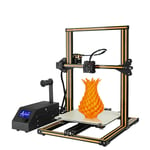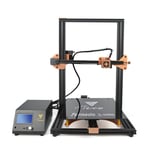Origins and Background
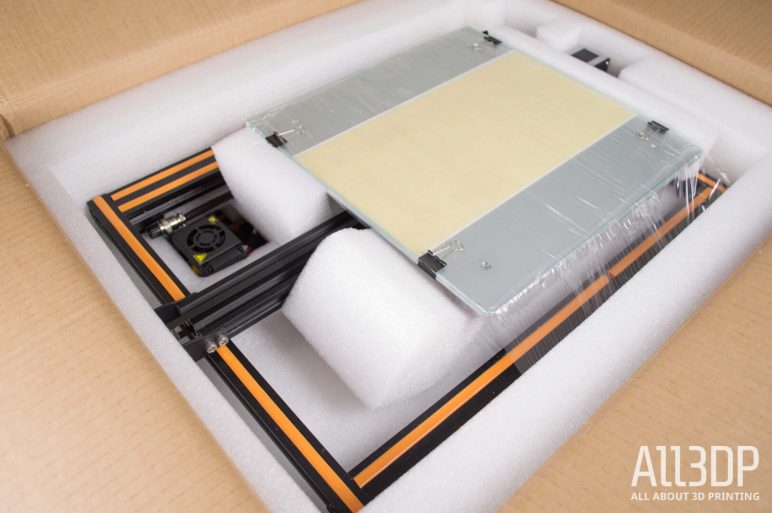
When it comes to large-volume Prusa-style printers, there’s no denying that the Creality CR-10 is among the most popular, but the Tevo Tornado is reputed to be equally popular and in some cases even better than its competitor.
The CR-10 gained huge popularity in the summer of 2017, following its release by Creality3D. The printer was one of the first ever to offer a massive build volume and medium to high quality prints, for less than $500 USD. Although there were a few speedbumps along the way, the CR-10 has become something of a mascot for large volume printers, with much of the community now using it as a benchmark against which newer printers are tested.
Tevo, another Chinese 3D printer manufacturer, was quick to jump on board with their subsequent release of the Tornado. The Tornado shares the same huge Prusa i3 setup, but has some notable differences. Not just another clone, the Tornado took some of the biggest complaints made by the community and improved apon them, for instance the heated bed. And to top it all off Tevo even managed to put it on the market for almost $50 less than the original CR-10 (a fluctuating value).
These differences have sparked the huge debate that we will be breaking down today: Tevo Tornado vs Creality CR-10. Just be warned — after seeing the facts and making a comparison, one of these two printers could very well become your new favorite machine.
Specs and Overview: Creality CR-10

The CR-10 is by all standards a massive printer, one of the leading traits in new releases today. It also offers top quality prints, and has an industrial looking frame made of 2020 and 2040 aluminum extrusion, something required to maintain rigidity in the huge frame.
The build volume measures 300 x 300 x 400 mm³ (11.81 x 11.81 x 15.75 in³) and it’s kept warm by a DC-powered heated bed. One of the major complaints about this is that the bed cannot reach the 100 degrees Celcius required to print ABS without the user first insulating the printer.
The control box is situated as a separate unit, with a standard blue graphic LCD and rotary knob for the interface. The power supply is inside the control box, and comes neatly prewired. A common complaint is that the cooling fan is noisy and always on, making the printer overall louder even in standby modes.
The wires come nicely labeled, and have a very simple plug-and-play setup with barrel connectors on the control box end. Pretty much all the cable management has been done for you, the only complaint some users have is that the wires are a bit short.
The printer comes mostly assembled out of the box, with an advertised “5-minute setup time”. This isn’t quite accurate as you must also level the bed, but you can definitely get the CR-10 up and running within half an hour, a huge improvement over the 6-hour build time of most kit printers in the same price range.
For the entire review, have a look at the full article on All3DP.
Here’s the breakdown:
- Build Volume: 300 x 300 x 400 mm³
- Heated Bed: Yes, DC 12V
- Control Box: External
- Wiring: Plug-and-Play, Pre-labeled
- Interface: Graphic LCD with Rotary Knob
- Build Surface: Glass (replaceable with other surfaces)
- Operating Voltage: DC 12V
- Input Voltage: AC 110V – 240V
- Frame Type: Aluminum Extrusion
- Extruder Type: Stock Metal
Specs and Overview: Tevo Tornado
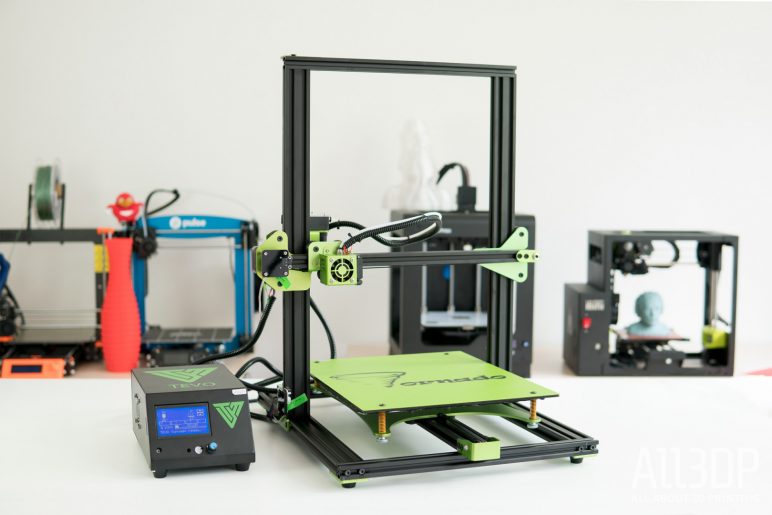
Essentially a watermelon-colored upgrade of the CR-10, the Tevo Tornado has some of its own unique features to add to the mix.
The Tornado features the same 300 x 300 x 400 mm³ build volume, and again the same aluminum frame design as the CR-10, with minute differences (mostly in the brackets). The assembly time is very similar, as the Tornado comes mostly assembled just like its counterpart.
Noted as one of the better features, the Tornado features a Titan extruder, or at least Tevo’s cloned derivative. Some community members have complained that the clone has some major flaws that result in a loss of quality with some filaments, notably flexibles, but the majority are content with the design.
Another huge improvement is the heated bed. The bed has a silicone AC heater powered by mains voltage, ensuring fast heat up times and the ability to easily maintain high temperatures. One worry pointed out by many users is the lack of cable support. The wires are soldered and glued, but there is no tension relief bracket in case the wires get caught, and continuous use can wear out the solder and glue to the point where the cables just might fall off and short.
The bed features a BuildTak sticker type surface for printing, and comes with a spare in the box. Some community members will tell you great things about the print surface, others hate it. It really depends on your preferences, but it has been noted that the surface is easily damaged (hence the spare).
Another improvement pointed out by the community is the power supply fan. On the Tornado, it would seem as though the fan has a temperature activated control, so the fan only runs when it needs to, reducing noise.
The Tornado has a similar but smaller external control box, again with plug-and-play wiring. The interface is a graphic LCD with rotary knob.
For a full review, check out this article by All3DP.
- Build Volume: 300 x 300 x 400 mm³
- Heated Bed: Yes, AC 110V – 240V
- Control Box: External
- Wiring: Plug-and-Play, Pre-labeled
- Interface: Graphic LCD with Rotary Knob
- Build Surface: BuildTak Type Sticker (replaceable with other surfaces)
- Operating Voltage: DC 12V
- Input Voltage: AC 110V – 240V
- Frame Type: Aluminum Extrusion
- Extruder Type: Titan (clone/derivative)
The Gunslingin' Comparison
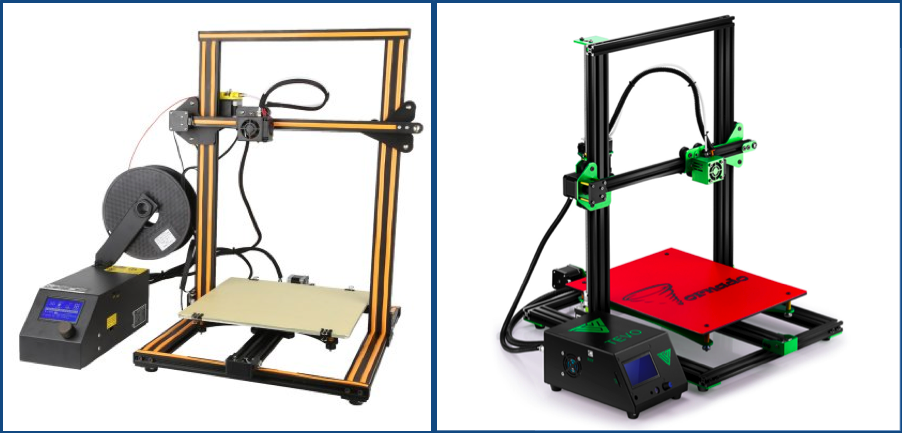
Now for the Tevo Tornado vs Creality CR-10 showdown: A side-by side comparison.
Out of the box, neither printer is quite perfect, and some (or all) settings will definitely need tweaking. On the CR-10, acceleration and jerk settings may need adjustment, and over/under extrusion could also be a problem. On the Tornado, a boot-up bug will plague some printers (depending on when they were manufactured), and salmon skin artifacts will occur.
On both printers, the huge beds become culprit for some problems, as the weight being thrown back and forth causes problems such as ringing/ghosting. Decreasing acceleration and jerk as well as adding TL Smoothers help fix these problems. The Tornado especially needs TL Smoothers to fix the salmon skin.
Another point of comparison is noise. Community members have measured the levels on both printers to be between 50 and 60 decibels, with the CR-10 being slightly louder due to the power supply fan, as mentioned earlier. Upgrades to both, such as vibration dampeners and silent fans can bring the noise down to 50-55 dB, which is still noisy but definitely less so.
Print speeds on both are quite low, especially compared to higher end printers. This is again attributed to the print beds being so large. Both are rated for a maximum of 150mm/s. The Tornado has a recommended print speed of 60mm/s, while the CR-10 has no officially recommended speed, and community members agree that around 70mm/s is best.
Heat-up time is where the Tornado becomes champion, warming to around 100º C in under 15 minutes, while the CR-10 can barely make it to 80º C in half an hour. Of course the CR-10 could be upgraded to an AC bed as well, but that requires an investment of another $100 that many would rather not spend.
Print quality can also be a concern. As mentioned previously, ghosting can affect both printers, and the Tornado will have the salmon skin effect, which makes prints less-than-perfect. Both have a rated layer resolution of 0.1mm, and of course the material precision is based on your nozzle diameter.
Without upgrades, the CR-10 can still print amazingly detailed models, provided your settings and calibration are right. On the Tornado, you really ought to add TL Smoothers to get the same results, and community-made comparisons seem to be in agreement. There are a few comparisons by community members where the stock Tornado does outperform a CR-10, so it is possible it depends on your particular printer.
The Verdict

So which is better? Tevo Tornado or Creality CR-10?
Well, as with many things in 3D printing, that really depends on you and your preferences. “Better” is a term relative to the user and how you want your printer to perform.
Do you want more advanced features out of the box, and are okay with doing multiple upgrades and maintenance to groom your printer to perfection? Then the Tevo Tornado is for you.
Do you want a continually reliable, relatively low-maintenance powerhorse? The Creality CR-10 probably has your back.
With the community still locked in battle over which is better, it’s up to you to decide…
CERTAIN CONTENT THAT APPEARS ON THIS SITE COMES FROM AMAZON. THIS CONTENT IS PROVIDED ‘AS IS’ AND IS SUBJECT TO CHANGE OR REMOVAL AT ANY TIME.
